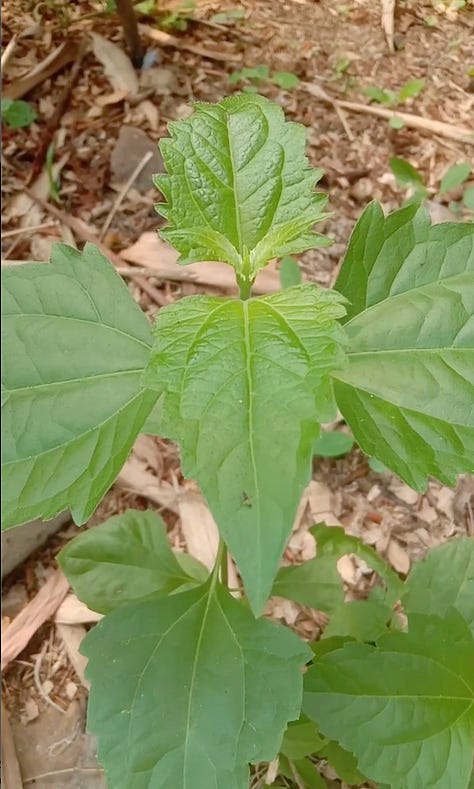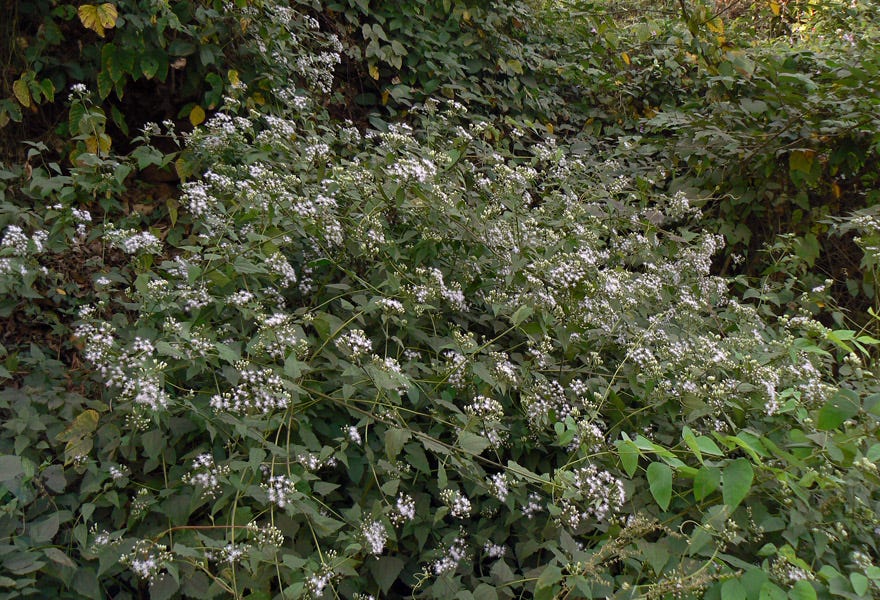If you’re a salsa aficionado like me, you may have heard Hector Lavoe sing “Date un baño, tienes que hacerte una limpieza, con Rompe Saragüey ”.
Rompesaraguey is a tropical and subtropical flowering perennial shrub in the Asteraceae family. Scientific name Chromolaena odorata (aka Eupatorium Odoratum), part of the Boneset sub-family, and close relative to Abre Camino / Roadopener / Florida Keys Thoroughwort, scientific name Koanophyllon villosum (aka Eupatorium Villosum).
Rompesaraguey is also know as Siam weed, Rouge plant, Christmas bush, Jack in the Box/Bush, Devil weed, common floss flower, Hagunoy (Cebuano language), Abani di egwu or Nsiibilibe (Igbo language), ewé Akíntọ́lá or Awolowo (Yorùbá language).
It is native to the Americas, but has been naturalized in Tropical Asia, Africa and Australia. It is considered an invasive species. In open areas, it can grow up 2.5m in height, while in shady areas, it can behave like a creeper, growing up to 10m.
The leaves are hairy and aromatic, especially when crushed. They are opposite, triangular to elliptical with serrated edges, 4–10 cm long by 1–5 cm wide. The white to pale pink tubular flowers are in panicles of 10 to 35 flowers that form at the ends of branches.



The seeds are achenes and are somewhat hairy. They are mostly spread by the wind, but can also be dispersed long distance by catching a ride on a person, animal or object. Seed production is about 80-90K per plant. Seeds need light to germinate. The plant can regenerate from the roots.
Its phytochemical composition includes alkaloids, flavonoids, saponins, tannins, terpenoids, phenolics, essential oils, quercetin, eupolin and more. It is considered to have anti-cancer, anti-diabetic, anti-hepatotoxic, anti-pyretic, analgesic, antimicrobial and antibacterial properties.
A study in Biomedicine and Pharmacotherapy (2021) posits that this plant’s high flavonoid and phenolic content is the reason that it works so well as a free radical scavenger, metal chelator, and antioxidant. Earlier studies have also pointed to its anti-inflammatory, anti-microbial, anti-oxidative properties when it comes to skin healing. It can be applied as a poultice on wounds to aid healing, reduce inflammation and protect from pathogens
Many Caribbeans, for example Jamaicans and the Garifuna, traditionally make a Bush Tea to reap this plant’s benefits. Combined with the expectorant properties of its compounds, it makes a useful treatment for coughs and inflammatory respiratory conditions. They also crush its leaves and inhale the fragrance to relieve congestion.
In Mexican herbal medicine, it is brewed, in combination with the root or bark of elemuy (Malmea depressa) and corn silks (Zea mays) to treat urinary retention. It is also included in an infusion, along with other herbs (Cruz Dulce Chica (sp. n/r), red willow (Salix humboldtiana) and potonxihuite (Cestrum dumetorum) to treat women experiencing postpartum infection known as puerperal fever. The infusion can be applied through compresses along the head and neck, as well as a soak bath. The Sociedad Farmaceutica de Mexico notes its use as a tonic, and as a treatment for gastroenteritis and liver conditions.
In West Africa, it is used in the prevention and treatment of Malaria. It is prepared in an herbal tea infusion along with lemongrass and mango leaves. It is used for its anti-inflammatory and analgesic properties in the treatment of rheumatic conditions. It is also used for the maintenance of women’s reproductive health and the prevention of cervical cancer.
It should not to be taken internally by pregnant women or breastfeeding mothers. This information is for educational purposes only. Always consult an experienced herbalist or medical practitioner prior to using.
As for spiritual uses, Rompezaraguey is popular in the Caribbean and in West Africa. It’s used to cleanse a person or space of evil spirits, negative energy, and bad luck. Its name alludes to its ability to break (rompe from the verb romper) curses, witchcraft and toxic ties. I’ve benefitted from it in bunches or brooms of herbs that are used for despojos (ritual cleansings) as well as in baños (lustral baths) or baldeos (floor wash). It can also be boiled in a large pot and the vapor used to cleanse a person, in a way somewhat akin to a yoni steam. A bunch, or a cross made from its stems, can be hung at the door. The leaves and stems can be dried and ground into a powder to spread around a space.



